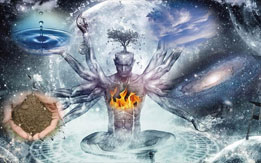The basic premise of Ayurveda is that the entire cosmos or universe is part of one singular absolute. Everything that exists in the vast external universe (macrocosm), also appears in the internal cosmos of the human body (microcosm). Man is the epitome of the universe. Within man, there is as much diversity as in the world outside. Similarly, the outside world is as diverse as human beings themselves. In other words, all human beings are a living microcosm of the universe and the universe is a living macrocosm of the human beings.
The Pancha Mahabhuta, or "five great elements", of Ayurveda are:
Hence, Ayurveda advocates: "YatPinde, Tat Bramhande"

The universe consists of 5 elements called the Panchabhutal. Our bodies, as a part of the universe, are also composed of these 5 elements:
Space
It accommodates all the components of the tripod of life - the Spirit, Mind & Body.
Air
The elan Vital - a creative principle, the Vital force and the impluse of life.
Fire
our body is made of food, sustained by it and ends up as food.
All these transformations in metabolism is governed by the fire of life.
Water
The elixir of life, the energy that governs cohesive and adhesive integrity the flow that cleanses and transports vital elements.
Earth
The structural arena where the orchestra of life exists with all its vibrancy.